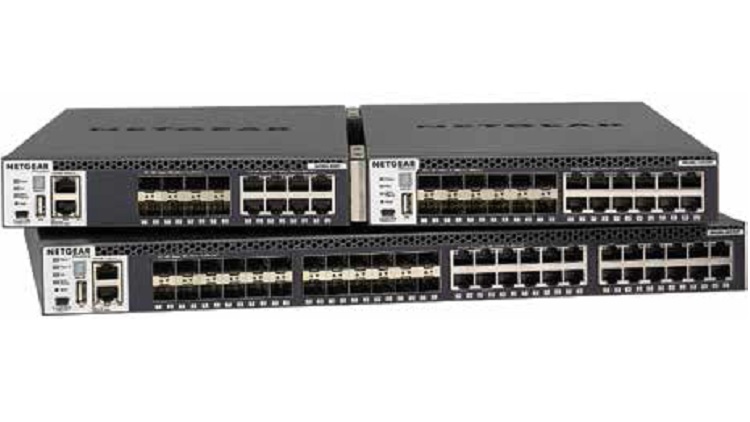You can’t converge AV and IT on a 1 Gbps network. But I have good news: you don’t need to. The convergence of AV and IT looms, we are told. Any Day Now™, IT systems and AV systems will magically meld seamlessly into one another, yet that day seems to be forever in the future.
The holdup is no longer bandwidth. It is shared bandwidth. The benefit of AV and IT convergence is the cost reduction to manage a single infrastructure rather than two or more. Today’s 1 Gb AV-over-IP solutions create AV systems that coexist in parallel with IT: two infrastructures that must be maintained separately.
LATENCY VS. BANDWIDTH VS. QUALITY

10 GbE infrastructure prices are falling. NETGEAR’s M4300-series is available for under $100 per port, with a mix of copper and fiber ports. In its native form, HDMI video consumes a ton of bandwidth—from around 2 Gbps to around 18 Gbps. To fit this into a 1 Gbps pipe, you need compression. A lot of compression. Any compression scheme trades off three features against one another: latency, bandwidth, and image quality. Achieving lower bandwidth without significant impact on quality requires more sophisticated algorithms. Those take longer to run, so latency goes up. Keeping latency low and quality high means compressing less—so bandwidth goes up.
Many pro AV applications demand zero latency and flawless image quality. This is the reason our matrix switches have held on so long, while the consumer video market long ago switched to high compression (MPEG) transmission over IP (Netflix, YouTube, even cable TV is IP today). The 1 Gbps class of AV-over-IP products cannot deliver on these requirements. Latency is too high and visual artifacts too common. Even if we could live with the quality and latency issues, these products consume hundreds of megabits per second, overwhelming a 1 Gbps data network with other traffic.
Find an IT professional with a working 1 Gbps data network. Now ask him or her if it’s ok for you to add dozens of video transmitters consuming hundreds of megabits each to their system. They won’t say yes, because they knows that can’t work. The users of the data network expect that nearly all of the 1 Gbps bandwidth is available to them for file downloads, collaboration, and even PC and mobile video streaming. If the AV system starts consuming the majority of bandwidth, then the data user’s experience is compromised.
PARALLEL NETWORKS AREN’T THE ANSWER
Realizing this, is has become standard practice is to create two parallel networks. Sitting alongside the 1 Gbps data network is a physically independent 1 Gbps Ethernet network dedicated solely to the AV system. What’s the point of that? If you want to build two infrastructures, make one of them HDBaseT and enjoy pristine video quality and no latency.
TRUE AV/IT CONVERGENCE = 10 GBE
To truly converge IT and AV networks, we need to upgrade the capacity of the network. 10 Gbps infrastructure is here, and it’s cheap—under $100 per port, compared to up to $1,000 per port for HDBaseT. Using a 10 Gbps network, 4K video can be transmitted without compression, while a full 1 Gbps (or more) can be set aside for the data network users. On top of that, no compression means no latency and no compromise of image quality. Performance is equal to that of the matrix switch, but the organization is left with only one infrastructure to maintain and manage.
EASY EXPANSION
Here’s the best part: the 10 Gbps equipment is an expansion of the 1 Gbps network. No more forklift upgrades to the AV system. Your existing 1 Gbps network and your new 10 Gbps AV switches can be interconnected, so that your existing 1 Gbps infrastructure can function as it always has, while the 10 Gbps upgrade is only needed where you want to add video capacity.
If your technology rooms are standalone “islands” of AV, just replace your 2K matrix switches with an inexpensive, low-port count 10 Gbps Ethernet switch (it’s easy to find a 16-port model for about $1600) and connect that up to your 1 Gbps network. If you would like to add AV distribution between rooms, you can directly link the rooms’ 10 Gbps switches (as you would have linked their matrix switches), or use the opportunity to take the money you saved on switchgear ($1,600 for your Ethernet switch vs $10k and up for a 16-port matrix switch) and use it to upgrade your IT infrastructure. Presto! Convergence! AV and IT both win.
In the compression tradeoff mentioned earlier – latency vs quality vs bandwidth, bandwidth stands alone. No one can create more time (latency). Video quality demands are going up and up (4K, 8K, HDR). Of the three, only bandwidth is getting cheaper. Make the right trade off.
Justin Kennington is the director of strategic and technical marketing for AptoVision, a Montreal-based technology company that provides its advanced BlueRiver chipsets for AV-KVM signal extension, matrix switching, IP-based switching, video wall and multi-view applications.
